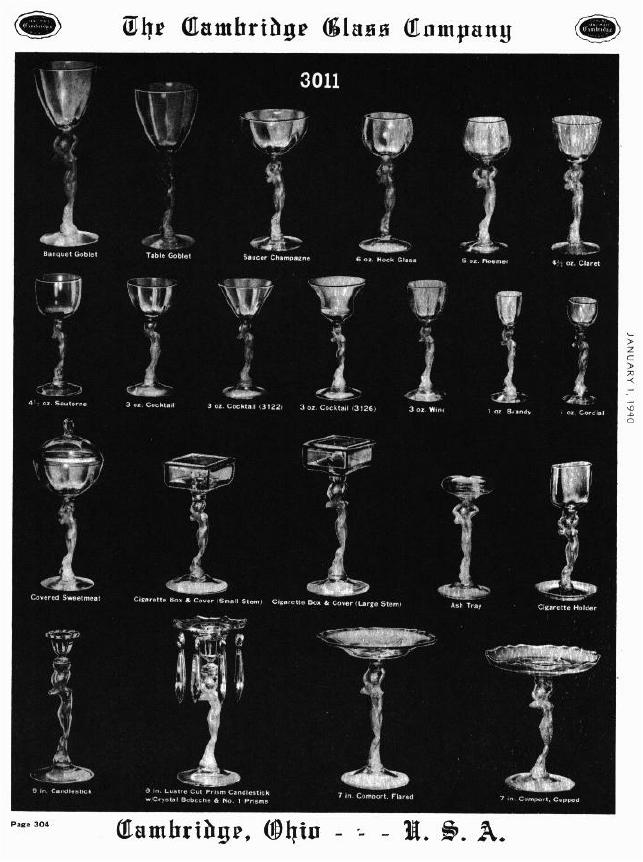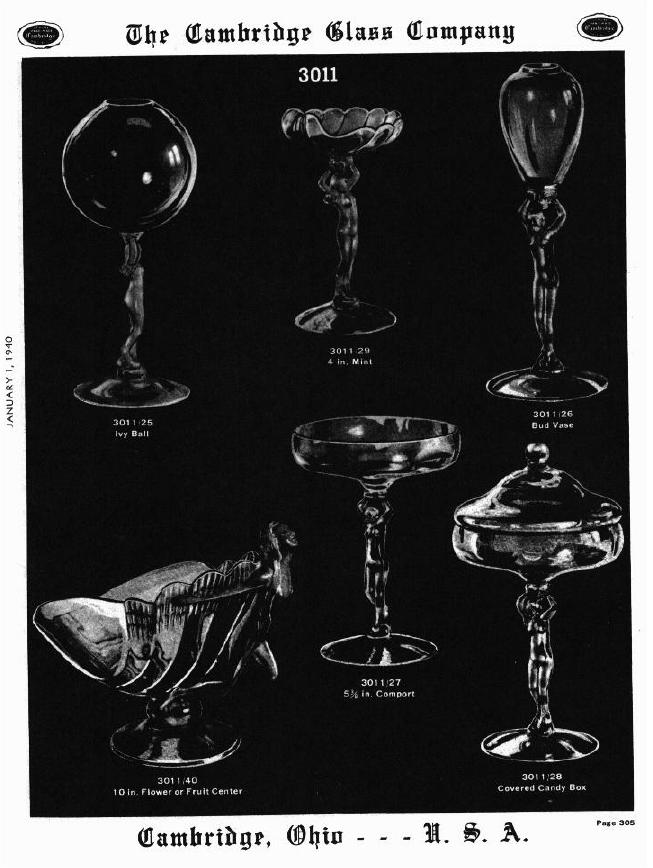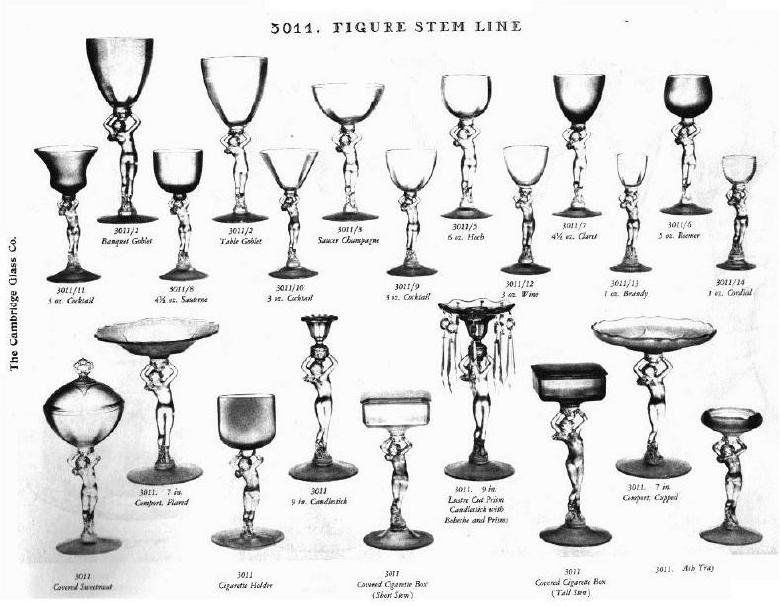National Cambridge Collectors, Inc.
A non-profit 501(c)(3) organization.

3011 Statuesque Line
by Lynn Welker
Crystal Ball Issue No. 57, January 1978
This month, we will look at a gigantic want list of all the known colors of the Statuesque or Nude Lady line for which the Cambridge Glass Company was so famous. This line was introduced in 1931 as the #3011 Figure Stem Line. Later, it was called Statuesque by the Cambridge Glass Company.
At the height of the line's popularity in the late 30's and early 40's, the line consisted of the twenty-eight items pictured on the catalog pages at the end of this article. The only exception known is a tall brandy glass shaped somewhat like the 5 oz. roemer but with a larger and longer bowl. The one known is all crystal and was not a production item.
As the line became less and less popular and Cambridge's fortunes dwindled, the line was narrowed down until only eight items remained by the early 50's. These were: cupped comport, ashtray, ivy ball, 3 oz. cocktail, cordial (formerly called the 1 oz. brandy), sherbet (formerly called the saucer champagne), and the table goblet.
The Nude Stem items were made primarily with crystal stem and foot with a colored top. Any of these could be purchased with a frosted stem or with a frosted stem and foot. The following is a list of colors that each Nude Stem item is known to exist in.
- #3011/25 Ivy Ball (9 ½" tall): crystal, all crown tuscan, amber, amethyst, forest green, carmen, royal blue, emerald green and mandarin gold.
- #3011/29 – 4" Mint (7 ¼" tall): crystal, amber, amethyst, carmen and royal blue.
- #3011/26 Bud Vase (10 ¼" tall): crystal, amber, amethyst, carmen, royal blue.
- #3011/40 – 10" Flower or Fruit Center (12" from head to back, varies between 8½" and 9 ½" in height depending on the tilt of the bowl): crystal, crown tuscan, amber, amethyst, forest green, carmen, royal blue, moonstone (frosted) and windsor blue.
- #3011/27 – 5 3/8" Comport: amber, carmen, royal blue and probably other colors.
- #3011/28 Covered Candy Box: royal blue, carmen and probably other colors.
- #3011/1 Banquet Goblet: carmen
- #3011/2 Table Goblet (9" tall): crystal, amber, amethyst, forest green, carmen, royal blue, emerald green, heatherbloom, gold krystol and mandarin gold. These also came with the crackle effect in mandarin gold, smoke, pistachio and carmen.
- #3011/3 Saucer Champagne (7 3/8" tall): crystal, amber, amethyst, forest green, carmen, royal blue, gold krystol, emerald green, mandarin gold. These also came with crackle effect in mandarin gold, smoke, pistachio and carmen.
- #3011/5 – 6 oz. Hock Glass (7 ¾" tall): royal blue.
- #3011/6 – 5 oz. Roemer (7 ¾" tall): royal blue.
- #3011/7 – 4 ½oz. Claret (7 5/8" tall): crystal, amber, amethyst, forest green, carmen, royal blue, moonstone (bowl frosted inside), heatherbloom and gold krystol.
- #3011/8 – 4 ½ oz Sauterne (6 ¾" tall): royal blue.
- #3011/9 – 3 oz. Cocktail (not quite 6 ½" tall): crystal, crown tuscan with a gold krystol bowl, amber, amethyst, forest green, carmen, royal blue, gold krystol, dianthus pink, emerald green, mandarin gold, tahoe blue, topaz (vaseline color), mocha, pistachio, smoke, moonlight blue, pink, blue-green (unknown color), carmen with crackle effect, ebony top and foot with crystal stem (very rare), ebony stem and foot with crystal bowl, and ebony stem with crystal foot and bowl. There are also a few cocktails known with a crown tuscan stem and foot with amber, amethyst, forest green, carmen and royal blue tops (these are all rare).
- #3011/10 – 3 oz. Cocktail (6 ¾" tall "V" style): royal blue.
- #3011/11 – 3 oz. Cocktail (7 ¼" tall "Tulip" style): amethyst, royal blue.
- #3011/12 – 3 oz. Wine (6 ½" tall): crystal, royal blue, topaz and probably other colors.
- #3011/13 – 1 oz. Brandy (6" tall): crystal, amber, amethyst, forest green, carmen, royal blue, emerald green, heatherbloom, gold krystol, mandarin gold, tahoe blue, mocha, pistachio, moonlight blue, pink.
- #3011/14 – 1 oz. Cordial (5 ¾" tall): crystal, amber, amethyst, forest green, carmen, royal blue, gold krystol.
- #3011 Covered Sweetmeat: amber, carmen, royal blue.
- #3011 – 7" Flared Comport (8" tall): crystal, crown tuscan, amber, forest green, amethyst, carmen, royal blue, heatherbloom, gold krystol.
- #3011 Cigarette Holder (7 ½" tall) with ashtray foot: crystal, amber, amethyst, forest green, carmen, royal blue.
- #3011 – 9" Candlestick and 9" Candlestick with Bobeche and Prisms (9 ½" tall w/bobeche – bobeche is sometimes colored to match the color of the candle cup): both type candlesticks were made in crystal, amber, amethyst, forest green, carmen, royal blue, crown tuscan and windsor blue.
- #3011 Cigarette Box and Cover (short stem 7 3/8" tall) and Cigarette Box and Cover (tall stem 8" tall): both of these cigarette boxes came in crystal, amber, amethyst, royal blue, forest green, carmen, gold krystol.
- #3011 – 7" Cupped Comport (comes in two sizes, 7" and 8 ½" tall depending which size Nude stem was used): crystal, crown tuscan, amber, carmen, amethyst, forest green, royal blue, heatherbloom, gold krystol, emerald green, mandarin gold, moonlight blue. One comport in this style is known with the entire top, stem and foot in pink, possibly peachblo. However, this was not a production item.
- #3011 Ashtray (varies from 6 ¼" to 6 5/8" tall): crystal, amber, amethyst, forest green, carmen, royal blue, gold krystol, emerald green, mandarin gold, mocha, pistachio, smoke, moonlight blue, pink.
Some variation in height will occur in the Nude Stem items. This is due to these pieces being made in three separate parts. Sometimes there is more glass thickness where the parts are joined. Also, the foot, being handmade, may be very flat or hollowed up in, allowing for a height difference.
Many decorations can be found on Cambridge Nude Lady pieces. The Charleton enamel floral and gold trim are sometimes seen on the all crown tuscan items. However, most other decorations are considered rare on Nude Stem items.
Among the more rare decorations seen on the Nude lady pieces are: Rockwell silver decorations (one is an elaborate filigree, another a mallard duck and cattails); gold trim edges; platinum trim edges, Gloria, Apple Blossom and Chintz etchings; Rosepoint, Diane and Portia etchings encrusted in gold (these generally occur on crown tuscan, but have been seen on crystal and carmen); gold overlay lace design (again, on crown tuscan); and rock crystal cuttings on crystal.
The crown tuscan cigarette box and cover, ashtray and flared comport were made with an ebony foot or with black enamel fired on top of the foot (these are considered rare). Some of the Nude Stem items with pale colored bowls such as heatherbloom, crystal, amber, etc. may have a line optic in the bowl.
The two nude comports (pictured here) with the Seashell plate tops were not considered a part of the #3011 Line by the Cambridge Glass Company, but were actually a part of the Seashell Line.
The smaller comport (5 ½" tall) was called the No. 10-5" comport, and the larger comport (7 ½" – 7 ¾" tall) was called the No. 11-7" comport. (The 5" and 7" refer to the width of the plate on top of the Nude.) The shell plate can be found with the flat edge of the shell at the back of the comport or turned to one side on the comport.
These comports were made primarily in crown tuscan and crystal. However, the larger comport was made entirely in mandarin gold and emerald green (dark), with the plate, figure and base all being colored. Although these were produced very late by Cambridge, they are extremely rare and seldom seen. As stated earlier, the crown tuscan comports are seen with gold trim edges and with Charleton enamel decorations.
Of the production colors, heatherbloom and windsor blue are the hardest to find in the Nude Lady line. The rarest of the serving or decorative pieces are the covered sweetmeat, candy box and cover and the mint. The hardest Nude stem glasses to find are the 6 oz. hock glass, the 5 oz roemer, the #3011/10 3 oz. cocktail ("V" style) and the #3011/11 3 oz. cocktail ("Tulip" style) , and the 3 oz. wine.
Happy New year and Happy Nude Lady Hunting!
 |
 |
 |